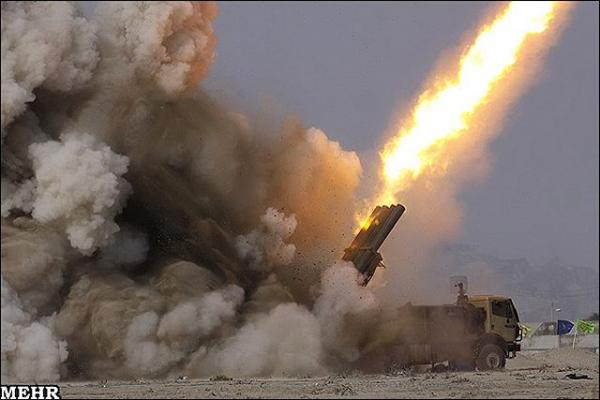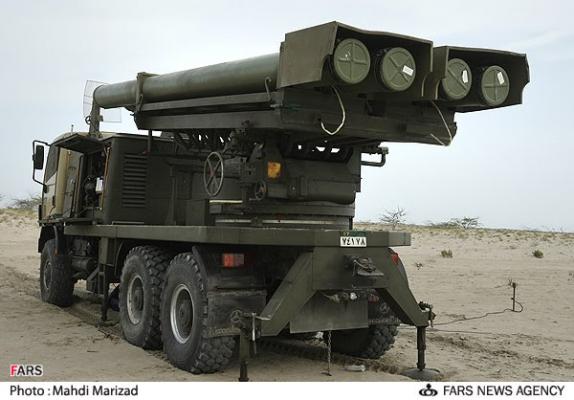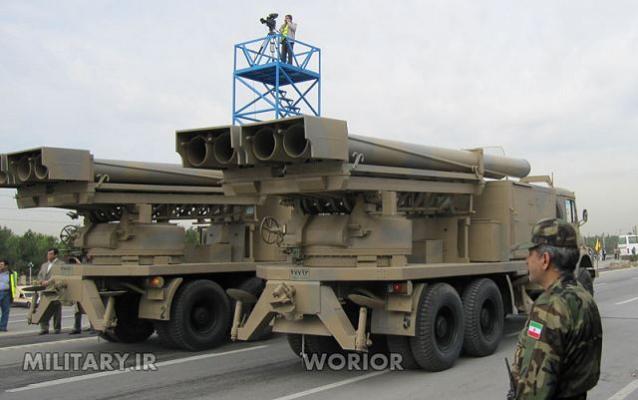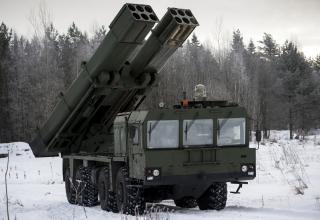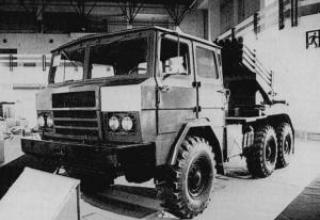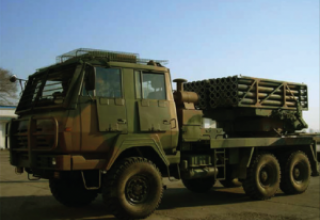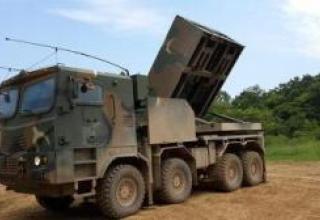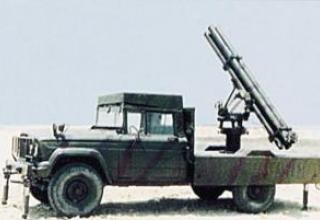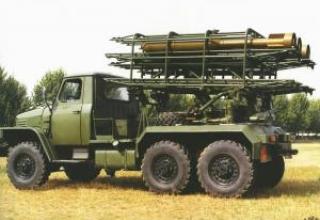The Fadjr-5 combat vehicle is designed to engage special-purpose targets: control and communication points, missile and artillery firing positions, radar facilities and areas of concentration of troops and military equipment, administrative and political centers of the enemy.
The system was developed by specialists from Shahid Bagheri Industries, a structural unit of the Aerospace Industries Organization of Iran, possibly with technical assistance from DPRK.
At present, it is in service with the Iranian Army and Hezbollah.
Composition:
The artillery part of the first samples of the Fadjr-5 combat vehicle was mounted on the modified chassis of the serial truck Mercese-Benz 2624 6×6, in the front part of which there is a sealed cabin and engine. At the present time, the modified chassis of the Mercedes-Benz 2631 truck is used, which is also used as a running gear of the Fadjr-3 combat vehicle.
The art part includes a package of four tubular rails, assembled in one horizontal row (see photo). According to published photos, the guides are provided with at least one guide groove under the projectile's drive pin. Behind the cabin is a calculation cabin. When shooting, the windshields of the cabin are usually closed by the blinds.
At the rear, on the left side, there are manual actuators to guide a pack of rails through the elevation angle and azimuth. Four jacks are used to stabilize the fighting vehicle when firing.
Unguided rockets (NURS) of 333-mm caliber with stabilizer blades are used for firing, which are opened after launch. In flight, the NURS is stabilized by rotating around its longitudinal axis. The projectiles can be equipped with different types of warheads: high-explosive, fragmentation, incendiary, smoke-smoking, or cassette-smoking in warhead equipment. The weight of the head unit is 175 kg. The shrapnel-flagged head unit is equipped with a head impact fuse.
The NURS are stored and transported in an individual cavity. The weight of the capping with the projectile is 1210 kg.
Shots are fired in single shots or volley. The interval between shells descending from the rails is 4-8s. After firing the fighting vehicle moves to the technical position. Reloading is carried out with the help of a crane.
The upgraded Fajr-5 combat vehicle is equipped with an automated fire control system (ALCS). The system allows for the calculation of data for firing, pointing and launching NURS from the cab of the combat vehicle or remotely using a remote control unit at a distance of up to 1000 meters.
A new addition to the LCMS is a network communication system to provide centralized fire control and data exchange between command and staff vehicles of several batteries and Fadjr-5 combat vehicles located up to 20 km away.
It has been reported that the Fadjr-5 BMD can be combined with a Surface-to-Surface Target Detection (SAR) naval radar, potentially enabling the Fadjr-5 to be used as an anti-ship weapon, for example in coastal counter-surface defence. The anti-ship capabilities of the system are expected to be enhanced through the use of upgraded Noor or Raad type NDTs as a means of attack.
On February 6, 2017 the Iranian Minister of Defense announced the beginning of serial production of a guided missile for the Fadjr-5 system.
Characteristics:
| Fighting vehicle Fadjr-5 | |
| Dimensions in camping position,mm - length - width - altitude |
10450 2540 3340 |
| Weight of combat vehicle, kg | 15000 |
| Maximum speed on paved roads, km/h. | 60 |
| Number of tubular rails, pcs. | 4 |
| Angle of elevation, ° - minimum - maximum |
0 +57 |
| Angle of horizontal firing, ° - to the right of the chassis axle - to the left of the driving axle |
45 45 |
| NURS technical data | |
| Caliber, mm | 333 |
| The length of the projectile, mm | 6485 |
| Weight, kg: - shell - shrapnel header - header charge |
915 175 (178) 90 |
| Maximum projectile range, m | 75000 |
| Maximum trajectory height when firing at maximum range, m | 30000 |
| projectile velocity, m/s | 1009 |
Testing:
It is alleged that two projectiles were launched towards the Israeli capital, the city of Tel Aviv, from Gaza on the evening of 15 November 2012.
The Palestinian terrorist organization Al-Quds Brigades, the militant wing of the Islamic Jihad, claimed responsibility for the shelling. According to their statement, two Fadjr-5 rockets were fired towards Tel Aviv, indicating that the group had hundreds of such rockets.
Sources:
- Christopher F Foss. Iran reveals more details of Fadjr rocket systems. // Jane’s defence weekly. – 26 April 2000. – Vol. 33. – № 17. – P. 16.
- FADJR-5. AEROSPACE INDUSTRIES ORGANIZATION.
- Jane’s Ammunition Handbook 2000-2001. – P. 635.
- Jane’s Armour and Artillery 2000-2001. – P. 783.
- http://english.farsnews.com/newstext.php?nn=9107120856 Опубликовано 20.11.2012 года.
- http://www.israel7.ru/News/News.aspx/156050#.UKus1oGsaSo Опубликовано 15.11.2012 года.
- http://thearkenstone.blogspot.com/2011/03/iranian-military-capability-2011-open.html
- Теунов Н. Реактивные системы залпового огня «Фаджр» сухопутных войск Ирана. Зарубежное Военное Обозрение, №11, 2011 г.
